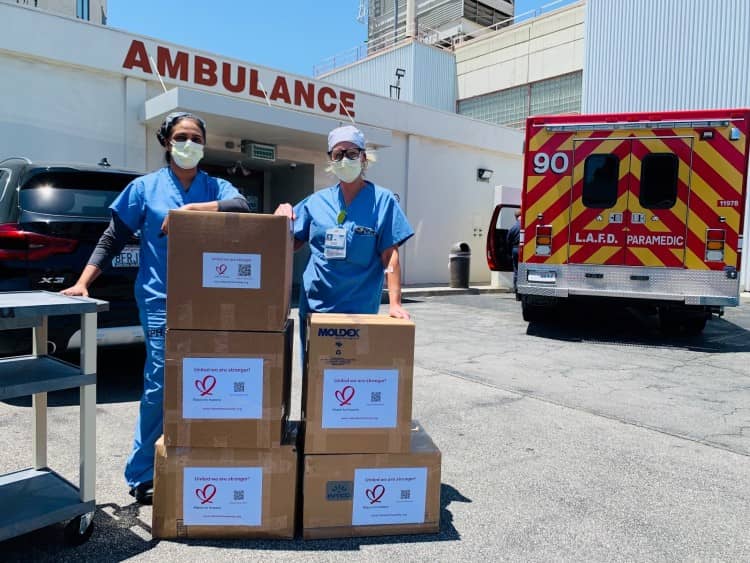Background
With the pandemic regathering itself for a second wave, and our societies still in the midst of their gravest crisis for 70 years, workforce wellbeing has taken centre stage. “Protecting health services” has been a strategic objective across all nations.
The workforce has been, and continues to be, exposed to substantial risk of harm in caring for patients during the pandemic. Evidence from systematic review that included previous SARS type epidemics reveals a substantial amount of mental distress in health care workers:
- General health concerns 62% (57-67)
- Fear 44% (34-54)
- Psychological distress 38% (28-48)
- Burnout 34% (19-54)
- Anxiety symptoms 29% (14-50)
- Depressive symptoms 26% (12-47)
- PTSD 21% (13-31)
- Stigma 16% (6-28)
[Salazar de Pablo, 2020]
Similar findings have been reported in a systematic review limited to COVID-19 pandemic [Pappa 2020].
The workforce also suffers direct harm from exposure to SARS-CoV2. They make up a substantial proportion of COVID-19 patients, around 10% in one systematic review [Sahu 2020]. At Monday morning’s session, Jeffrey Boord cited research estimating that health workers have three times the risk of contracting COVID-19 compared with the general population.
COVID-19 has put incredible strain on healthcare systems across the world that in many cases were already stretched to their limits. How do we support frontline workers to avoid burnout in these most challenging times?
Don Berwick, President Emeritus & Senior Fellow of the Institute for Healthcare Improvement, set the scene for us at the opening keynote. Quality improvement is about both the aims and the methods of making things better.
In health care, the IHI has formulated the “Triple Aim”:
- Better care for individuals – from reducing complications in hospitals to making sure care is focused on what matters to patients
- Better health for the population – better outcomes overall, better public health, improved engagement with services
- Reduction of cost – the elimination of waste and the focusing of resources where they matter most.
We cannot achieve these aims with a workforce that isn’t proud and joyous about what it does. And we cannot deliver quality in the pandemic without a clear focus on equity [link to blog]. Don spoke about all of this to Andre Tomlin from the National Elf Service:
For a more focused interview about the impact of the pandemic on Quality Improvement, check out his interview with Amar Shah, Chief Quality Officer at East London NHS Foundation Trust (ELFT) in England.
To find out more about how this has played out in workforce wellbeing and QI, let’s take a look at some of the discussions that took place at #Quality2020.
Our oxygen mask comes first: workforce safety
Stephen Muething, Organisation Cincinnati Children’s Hospital Medical Center; USA
Jeffrey Boord, Parkview Advanced Medical Simulation Lab, Parkview Health; USA
Stephen and Jeffrey got us off to a great start with a really clear, well-paced session on workforce safety. They underlined the risks health workers are exposed to, even pre-pandemic times. In the US, such workers face double the risk of a workplace incident compared to private sector workers in general. Around 10% of incidents result from assaults by patients.

Improving workforce safety also improves patient safety.
Improving workforce safety also improves patient safety.
All of the organisations in their collaborating health systems (Parkview Health, Indiana and Cincinatti Children’s, Ohio) have made workforce safety a strategic objective, aiming to achieve zero harm. You should explore their presentation to find out more about the framework they have developed. However, here are some key messages I took from the presentation.
- Early on, they built a theoretical framework to guide their thinking and drafting processes
- A senior management workgroup meets regularly to review safety
- They work with data that is as close to real-time as possible
- Transparency is key
- The partner organisations learn from each other
“We need to learn from others. Healthcare is behind on workforce safety. Others… are ahead of us and we can learn. That has been fundamental to this endeavour.”
A pandemic pivot
When the pandemic hit, the group swung into action, redrawing their framework to meet the challenge. An important limiting factor was the lack of testing in the early stages. Broadly, the strategy comprised three stages:
- Stopping the infection
- Safe reopening
- Emphasis on screening
- Flexible staff absence policies
- Stopping the spread
- Use of masks and adequate PPE
- Engineering and administrative controls (e.g. work patterns)
- Screening and testing for patients and visitors
- Stopping community spread
- Supporting safe practice in local organizations
- Promoting safe community behaviours
- Developing capacity for test, trace and isolate.
A provocation for kindness: why the “soft stuff” is the REAL work
Bob Klaber, Imperial College Healthcare NHS Trust; England
James Mountford, Royal Free NHS Foundation Trust; England
Suzie Bailey, The Kings Fund; England
Göran Henriks, Region Jönköping; Sweden
Anette Nilsson, Region Jönköping; Sweden
Maureen Bisognano, Institute for Healthcare Improvement (IHI); USA
Dominique Allwood, Health Foundation & Imperial College Healthcare NHS Trust; England
Gabrielle Matthews, Youth Expert Advisor, NHS England and NHS Improvement; England
This session was one of the highlights of the week. The presentations were short and punchy, and seamlessly managed by the facilitators. At various stages we moved into breakout rooms, and even did a “virtual fishbowl”, whatever that is. Fortunately, you can follow the Twitter discussion with Mark Brown here:
Hello! I'm Mark Brown and welcome to my second day live tweeting from @QualityForum for Beyond the Room. The first session I'm covering today is "A provocation for kindness: why the “soft stuff” is the REAL work (in health and care"), beginning very soon #quality2020
— Mark Brown (@MarkOneinFour) November 3, 2020
Kindness is the business end of health care. It is something we need to take very seriously. Care without kindness isn’t proper care. Care with kindness improves outcomes and reduces costs.
Nevertheless, it can sometimes it can be difficult to bring “soft” issues into a pressurised system Maureen had some good advice on starting these conversations. Firstly, start with a story. Then talk about the human cost, then financial cost. This arc of storytelling brings everyone together. She introduced a very simple example, the 30 seconds of kindness shown by an anesthetist to the patient just before the operation gets underway:
“I will be your anesthesiologist for today. I’ll be with you for the entire surgery. I’ll make sure you don’t have pain and I’ll make sure you get comfortably back to the recovery area.”
As a result, patients need less anaesthesia, and less pain medication afterwards. To explore the evidence around the impact of kindness, Maureen recommends Compassionomics.
There has never been a more important time to be kind.
People are rising to the challenge. Maureen told us about the Boston Bridge, a new network for connecting with isolated elderly people. Gabby is a medical student with experience of long term conditions. She spoke about the positive effects of random acts of kindness throughout her care.
She made one other key point. If you want to be kind, it helps if you feel an element of safety in yourself. So we move on to focus more specifically on staff wellbeing.
Restoring joy in work, prioritising wellbeing and preventing burnout during and post-COVID: lessons from the field
Jessica Perlo, Institute of Health Improvement; USA
Karen Turner, Royal Free London NHS Foundation Trust; England
Susan Hannah, Institute of Health Improvement; UK
Kate Slemeck, Royal Free London NHS Foundation Trust; England
Moving onto the workforce themselves, we conclude by revisiting one of the themes of #Quality2019 – Joy in Work. Jessica got off to a great start by acknowledging that for some people there’s a cringe factor with the phrase. To somebody slogging away with a sky-high workload, inadequate PPE and multiple ropey IT systems to contend with, the idea might seem somewhat remote.
People are entitled to joy in work
Scratch the surface for a second, and you realise that joy is intrinsic to work, and why we do it. I think I first really encountered the concept at school in the classic novel One Day in the Life of Ivan Denisovich. The protagonist, a brickie, sustains himself through his appalling ordeal by taking pride in his work. Work that doesn’t benefit him – it benefits the system that keeps him in thrall. Even so, he even goes as far as to risk harm to himself to make sure his bit of wall is built properly. And thus retains his humanity.
Joy in work is not just the absence of burnout
It was interesting to see the examples provided by the audience in the chat window of what gives them joy in work:
- Feeling we made a difference to someone’s care
- When a patient is appreciative of what I do
- Sharing ideas and chatting with people
- Getting things done whilst being appreciated
- Work is completed at a regular pace without any stumbles: both team and patients are satisfied
No brickies in the audience, but the same theme is there. That of taking sustenance from doing the job well. The other presentations focused on techniques you can use to push forward Joy-in-Work in various settings
Speaking of sustenance, I’ll finish with a great little story about donations to staff.
Karen Turner and colleagues from the Royal Free started out a Joy-in-Work programme by asking staff “What Matters to You?”. The end result was roughly 20% absolute risk reduction in staff turnover in ICU. I covered this session in the blog on co-production. This is appropriate because, as Karen’s experience shows, wellbeing at work needs to be co-produced with staff.

Staff were delighted to be given vegetables instead of the usual cakes and biscuits. Yes really.
The nursing teams at the Royal Free were finding that the supermarket shelves had been stripped bare by the pandemic public before they got off shift. So they asked if donations could be in the form of fresh vegetables instead of the usual cakes and biscuits. A simple step, but look at those joyous faces!
You can explore in more detail in the Twitter thread created by our woodland lurker The Mental Elf for this session:
Hello and welcome to a live #Quality2020 workshop on "Restoring Joy in Work, Prioritising Wellbeing and Preventing Burnout during and post COVID: Lessons from the Field”https://t.co/HjfDOXiENh
— The Mental Elf (@Mental_Elf) November 5, 2020
References
Pappa S, Ntella V, Giannakas T, Giannakoulis VG, Papoutsi E, Katsaounou P. Prevalence of depression, anxiety, and insomnia among healthcare workers during the COVID-19 pandemic: A systematic review and meta-analysis. Brain Behav Immun. 2020 Aug;88:901-907. doi: 10.1016/j.bbi.2020.05.026. Epub 2020 May 8. PMID: 32437915; PMCID: PMC7206431.
Sahu AK, Amrithanand VT, Mathew R, Aggarwal P, Nayer J, Bhoi S. COVID-19 in health care workers – A systematic review and meta-analysis. Am J Emerg Med. 2020 Sep;38(9):1727-1731. doi: 10.1016/j.ajem.2020.05.113. Epub 2020 Jun 6. PMID: 32738467.
Salazar de Pablo G, Vaquerizo-Serrano J, Catalan A, Arango C, Moreno C, Ferre F, Shin JI, Sullivan S, Brondino N, Solmi M, Fusar-Poli P. Impact of coronavirus syndromes on physical and mental health of health care workers: Systematic review and meta-analysis. J Affect Disord. 2020 Oct 1;275:48-57. doi: 10.1016/j.jad.2020.06.022. Epub 2020 Jun 25. PMID: 32658823; PMCID: PMC7314697.
Trzeciak S, Mazzarelli A. Compassionomics: The Revolutionary Scientific Evidence that Caring Makes a Difference. Studer Group, 2019.
Last updated: 6 November 2020, 16:24 GMT
Author: Douglas Badenoch, Beyond the Room
SHARE THE BLOG:


